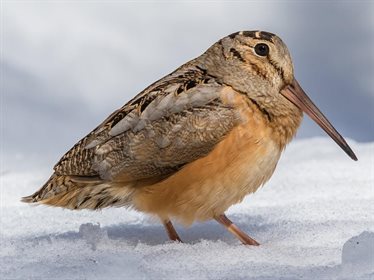
© Samuel Paul Galick

© Louis Brodeur

© Samuel Paul Galick
- A few facts from ALLABOUTBIRDS.ORG
-
- The male woodcock’s evening display flights are one of the magical natural sights of springtime in the East. He gives buzzy peent calls from a display area on the ground, then flies upward in a wide spiral. As he gets higher, his wings start to twitter. At a height of 200–350 feet the twittering becomes intermittent, and the bird starts to descend. He zigzags down, chirping as he goes, then lands silently (near a female, if she is present). Once on the ground, he resumes peenting and the display starts over again.
- Wouldn’t it be useful to have eyes in the back of your head? American Woodcocks come close—their large eyes are positioned high and near the back of their skull. This arrangement lets them keep watch for danger in the sky while they have their heads down probing in the soil for food.
- The conservationist Aldo Leopold wrote that the woodcock’s mesmerizing sky dances were “a refutation of the theory that the utility of a game bird is to serve as a target, or to pose gracefully on a slice of toast.” His writing helped spur the mid-twentieth century conservation movement.
- Some males display at several singing grounds and mate with multiple females. The female often visits four or more singing grounds before nesting, and she may keep up these visits even while she cares for her young. The male gives no parental care, and continues to display long after most females have laid eggs.
- Young woodcocks leave the nest a few hours after hatching, but for their first week they depend on their mother for food. They start to probe in dirt at three or four days after hatching.
- The woodcock is also known as the timberdoodle, Labrador twister, night partridge, and bog sucker.
- The oldest American Woodcock on record was 11 years, 4 months old.
- The American Woodcock probes the soil with its bill to search for earthworms, using its flexible bill tip to capture prey. The bird walks slowly and sometimes rocks its body back and forth, stepping heavily with its front foot. This action may make worms move around in the soil, increasing their detectability.
Habitat
Woodcocks nest in young, shrubby, deciduous forests, old fields, and mixed forest-agricultural-urban areas across the eastern United States and southern Canada. They display in forest openings and old fields in the springtime, and they often use clearings for roosting in the summer. On the western edge of their range, they may depend on moist, wooded riverside areas and wet meadows in young woodlands. Woodcocks spend the winter in similar habitats in southern part of breeding range, also moving into additional wintering habitat in Texas and on the southern edges of the Gulf States.
Food
American Woodcocks eat earthworms and other invertebrates they find in the soil, including snails, millipedes, spiders, flies, beetles, and ants. They forage by probing the soil with their long bills, which have flexible upper mandibles specialized for capturing and extracting earthworms. They sometimes rock their bodies backward and forward as they forage, shifting their weight heavily from foot to foot. The vibrations from this motion may prompt earthworms to move underground, making slight sounds that the woodcock may be able to hear or feel. They also eat small amounts of plant material, such as sedges, pigweed, and members of the rose family.
Nesting
Nest Placement
Woodcocks nest in exposed sites on the ground, usually in young upland woods.
Nest Description
The female makes a shallow depression in the leaf and twig litter, about 5 inches across and 1.5 inches deep. In some cases she lays eggs without hollowing out a nest bowl.
Nesting Facts
| Clutch Size: | 1-5 eggs |
| Egg Length: | 1.4-1.7 in (3.6-4.3 cm) |
| Egg Width: | 1.1-1.2 in (2.7-3.1 cm) |
| Incubation Period: | 20-22 days |
| Egg Description: | Grayish orange with splotches of brown, violet-gray or blue-gray. |
| Condition at Hatching: |
Active, well developed, and covered with thick gray and brown down. |
Behavior
The American Woodcock breeds early in spring, with males beginning their courtship displays—sky dancing at dawn and dusk—as early as December in the southern part of the range and as early as March in the north. Males mate with multiple females and give no parental care. The nesting female is quick to abandon a nest if it is disturbed in the early stages of incubation. Later on, she may respond to an intruder by first lying low and motionless, then flushing from the nest and feigning injury to distract the intruder. The female broods the nestlings only until they dry off; they all leave the nest together a few hours after hatching. She feeds the young for a week but they begin to probe for food on their own at 3-4 days. About a month later they become independent, moving around as individuals rather than with their siblings. Outside of the nesting season, woodcocks are generally solitary, though they may group into small clusters of 2–4 individuals. Physical contact between individuals is rare, but they may sometimes tug bills.
